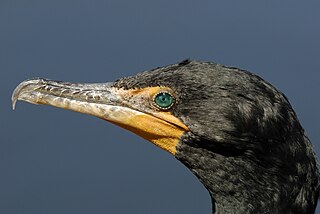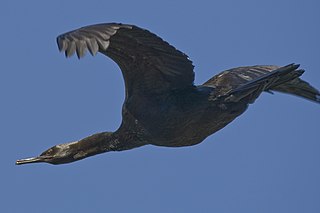 W
WPhalacrocoracidae is a family of approximately 40 species of aquatic birds commonly known as cormorants and shags. Several different classifications of the family have been proposed recently and the number of genera is disputed. The great cormorant and the common shag are the only two species of the family commonly encountered on the British Isles and "cormorant" and "shag" appellations have been later assigned to different species in the family somewhat haphazardly.
 W
WCormorant culling is the intentional killing of cormorants by humans for the purposes of wildlife management. It has been practiced for centuries, with supporters of culling generally arising from the angling community. Culling techniques may involve the killing of birds, the destruction of eggs or both. Historically, culls have occurred to protect the interests of recreational and commercial fishermen who perceive the animals to be competing with them for their intended catch or for the prey of their intended catch. Since the 1960s, the growing aquaculture industry has undertaken cormorant culls to protect its farmed fish and crustacean stocks. Opponents of cormorant culling include conservation groups such as the National Audubon Society, Cormorant Defenders International and Sea Shepherd.
 W
WCormorant fishing is a traditional fishing method in which fishermen use trained cormorants to fish in rivers. Historically, cormorant fishing has taken place in Japan and China, as well as Greece, North Macedonia, and, briefly, England and France. It is first attested as a method used by the ancient Japanese in the Book of Sui, the official history of the Sui Dynasty of China, completed in 636 CE. This technique has also been used in other countries but is currently under threat in China.
 W
WThe Cormorant Fishing House is a museum dedicated to Cormorant Fishing on the Nagara River and located in the city of Gifu, Gifu Prefecture, Japan. In addition to viewing artifacts from the history of cormorant fishing, visitors can also view the cormorants actually used in the process. The museum is run by the cormorant fishing masters, who are Imperial Agents of the Royal Household Agency.
 W
WCormorant fishing on the Nagara River has played a vital role in the history of the city of Gifu, Gifu Prefecture, Japan. Throughout its long history, it evolved from a means to live, to a profitable industry, to a major tourist draw. It runs from May 11 to October 15 of each year.
 W
WThe pelagic cormorant, also known as Baird's cormorant, is a small member of the cormorant family Phalacrocoracidae. Analogous to other smallish cormorants, it is also called the pelagic shag occasionally. This seabird lives along the coasts of the northern Pacific; during winter it can also be found in the open ocean. Pelagic cormorants have relatively short wings due to their need for economical movement underwater, and consequently have the highest flight costs of any bird.
 W
WThe red-faced cormorant, red-faced shag or violet shag, is a bird species of the family Phalacrocoracidae.